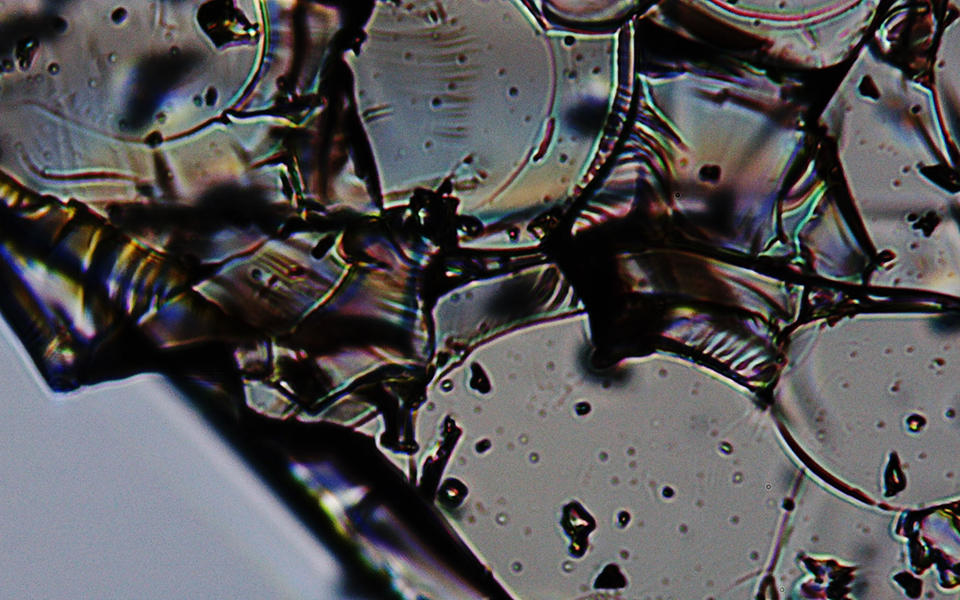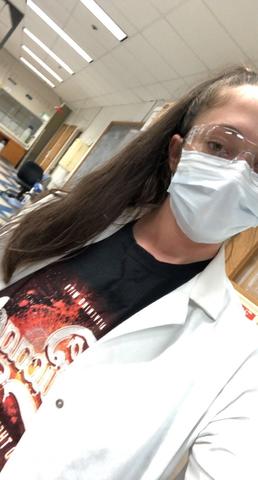Taking Measure
Just a Standard Blog

Microscopy image of the fractured glass showing light diffraction.
This summer was an interesting one, to say the least. I was in the Summer Undergraduate Research Fellowship (SURF) program offered by the National Institute of Standards and Technology (NIST).
As my summer project, I studied organic glasses, solid materials composed of molecules that are arranged in a unique amorphous (or disordered) pattern in 3D space. Glasses can be used as a preservative by encapsulating molecules in their empty spaces. After reviewing the World Health Organization (WHO) list of essential medicines, I identified broad range antibiotics that don’t dissolve well and are therefore less effective on the human body than desired, and determined which ones had molecular structures that were not “solved” or fully understood. I then set about finding ways to improve the solubility and stability of these types of compounds using organic glasses, which could be applicable to situations like transporting unstable drugs to developing nations, and more.
While many of my fellow students were unable to perform research in the lab due to the pandemic and had to use simulated data this summer, I was able to do lab work through my home institution of Southern Methodist University (SMU). I performed multiple experiments using instruments in the laboratory and ended up with much data to work with, which I was then able to present at the end of the summer.
I was able to meet with my mentor, Craig Brown, regularly during the program, as well as members of his lab group such as Ryan Klein, who helped me develop my skill sets in structure solutions and neutron diffraction data analysis. I was able to gain experience not only through the program, but also hands-on in the lab with the instruments. I used instruments ranging from differential scanning calorimeters, which gave information about glass transitions (or transitions where something changes from a “glassy” state to a rubbery state), to a nuclear magnetic resonance spectrometer, an instrument designed to work with a property of molecules known as spin in order to determine their structures.
This was excellent not only for my fellowship, but also for my future graduate school plans. I am attending SMU for my graduate work in physical chemistry — the branch of chemistry that seeks mathematical and physics-based answers to chemical questions such as whether we can create a superconductor that works at room temperature. I chose this field because I love math and physics, but I knew engineering wasn’t my calling. I fell in love with physical chemistry when I took the course in my undergraduate career as a sophomore, and never looked back.

I used this program to not only develop my strategy for graduate school — it helped me to determine what project I should pursue initially for my dissertation — but also become acquainted with neutrons and sources of neutrons for potential future projects (my colleagues and I have plans to submit a proposal to conduct experiments using neutron beams soon). My plans for graduate school include developing my organic glasses project, working on new projects with other pharmaceutical applications, and broadening my research base in general including developing my skill set.
It was an excellent experience, and I appreciated all the effort to make this past summer’s program as immersive as possible amid the COVID-19 pandemic. I highly recommend the SURF program. The program’s directors were incredibly supportive during these times with projects and deadlines. They really wanted us to get the most out of this fellowship by meeting with peers and colleagues. I also appreciated meeting with individuals, such as scientists like Susana Teixeira and directors like Brandi Toliver, who showed that women in STEM are not only in the field but are in positions of power within the scientific community.
I look forward to being part of that community and taking the next steps in my career.





